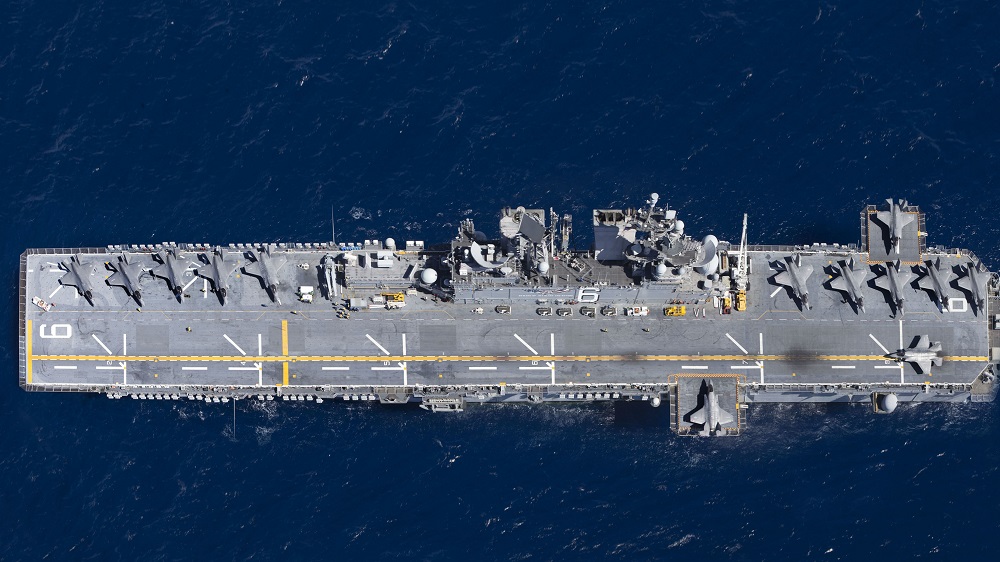South Korea has announced it will build the country’s first real aircraft carrier designed to carry up to 15 F-35B stealth vertical/short takeoff and landing (VSTOL) jet fighters. In doing so, this American ally joins other key allies – UK, Japan, and perhaps Australia – in their moves toward similar F-35B medium carrier capabilities.
South Korea’s 2021-2025 defense blueprint, reported on August 11 by US Naval Institute News, “provides fresh details on the plans to develop an aircraft carrier capability for the Republic of Korea (RoK) Navy. The LPX-II project will be a dedicated light aircraft carrier for F-35B; it will not be an amphibious assault ship.”
In this way, it will be like the initial America-class air assault LHAs.
As noted by Popular Mechanics, the proposed ship will be less than one-third the size of an American supercarrier, but at 40,000 tons, the ship will be the largest warship ever constructed on the Korean peninsula. It also “will enhance South Korea’s power projection capability while keeping a large number of stealthy warplanes safe from North Korean surprise attack.”
After Japan, South Korea is one of the largest buyers of the F-35, with orders for 40 F-35As (the conventional takeoff and landing version used by the U.S. Air Force) and 20 F-35Bs. Popular Mechanics explains this F-35B order likely means the RoK Navy intends to load 15 of these fighters on their new ship, and keep the rest for spares and training.
The U.S. State Department also recently announced a massive $23 billion deal to sell Japan 105 F-35 Joint Strike Fighters. And as The Drive noted, the contract also includes 42 F-35B V/STOL jets. “This opens the door for the Japan Air Self-Defense Force (JASDF) to conduct fixed-wing operations from Japan’s two Izumo class helicopter carriers.”
This will give Japan its first fixed-wing carrier capability since WWII. Once completed this sale would also make Japan the second-biggest operator of the F-35, after the U.S.
And then there is Australia which is considering deploying F-35B aboard its two Canberra class amphibious assault LHDs, which are like U.S. Wasp-class ships. Australia is still debating the merits of adding F-35BAs to these amphibious ships.
But, Defense Connect notes, “What if Australia actively pursued what the United States Studies Centre (USSC) defines as ‘capability aggregation and collective deterrence in the Indo-Pacific’ by enabling the cross-decking of American, Japanese, South Korean and eventually British F-35Bs operating in the region?”
Simply put, this would enable Australia’s Canberra class ships to deploy F-35Bs from U.S. and other allied forces in time of need. Integrating Australia’s amphib ships with these other allied F-35B capabilities would be a considerable naval airpower force multiplier.
Meanwhile, across the world, British Royal Navy’s F-35 Lightning II jets have just embarked on its new HMS Queen Elizabeth F-35 aircraft carrier as the service prepares for the fighter aircraft to operate from the sea. Initially, it will also operate U.S. Marine Corps F-35Bs until the Royal Navy can add its full complement of its own F-35s.
The Queen Elizabeth will be followed soon by Britain’s second new F-35B carrier, the HMS Prince of Wales.
The “game-changing” F-35B stealth fighter and the new “Lightning Carrier” concept employed by the U.S. Navy and Marines, along with similar new capabilities from its allies, will dramatically increase U.S. and allied naval air power during any major crisis.

Advertisement
Help President Trump Stop Joe Biden [ACT NOW]















All the West’s Air Craft Carriers are merely targets against fast nuclear torpedoes and fast maneuvering mach 4 (plus) hyper-sonic anti-ship and mach 8 (plus) hyper-glide ‘anti-anything else’ intercontinental missiles Russia has deployed in 2019 and 2020. China and Iran will soon follow.
The US Navy Sea Wiz 20mm Vulcan Gatling-style rotary cannon can only track one target at a time. A mass launch of missiles from very short range will defeat it.
US radar must have the capability to track multiple (10 to 20 Mach 4 Hyper-sonic anti-ship missiles from very short range, say inside the sea of Japan, Yellow Sea, Formosa Straight, Persian Gulf or the Black Sea.
Russia and China will have the capability the hit carrier groups with hyper-sonic missiles before they can get in operational range to launch airstrikes, as the upcoming F-35 stealth fighter jets have a combat radius of 450-600 miles, meanwhile hyper-sonic missiles potentially have a range in excess of 1,200 miles.
That makes the Carriers obsolete…………..UNLESS, a fleet wide, integrated jam proof radar defense exists (two years ago) that is hardened against an EMP first strike, armed with dozens of Sea Wiz cannons and lasers that can quickly identify and ‘select individual targets’ from the waves of incoming swarms of missiles and cheap decoys in mere minutes or less.
So our allies are buying our F35s. And NO ONE sees that this is the results of a PRO MILITARY president in office who is making jobs for America???? No, you will note that not even this article made mention of the FACT that this was creating American jobs.